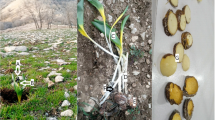Abstract
The anticancer activity of ginseng originated mainly from lipid-soluble components. The hexane extract of ginseng marc (HEGM) showed a potent inhibitory activity on human hepatoma (HepG2, GI50 = 41.7 μg/ml) and breast (MCF-7, GI50 = 54.4 μg/ml) cancer cell proliferation in vitro in a concentration-dependent manner as did the hexane extract of ginseng (HEG), with GI50 values of 21.1 μg/ml in HepG2 and 41.2 μg/ml in MCF-7. The water extract of ginseng (WEG) possessed a low anticancer activity against both cancer cell lines, but the hexane-soluble fraction of WEG (HSF/WEG) showed a potent anticancer activity against HepG2 (GI50 = 38.7 μg/ml) and MCF-7 cells (GI50 = 51.1 μg/ml). The hexane extraction in ginseng was a very promising protocol for the maximum recovery of the anticancer active components in high concentrations. Also the adoption of hexane extraction after water extraction of ginseng was successful in the effective utilization of the residual lipid-soluble anticancer active components in ginseng marc.




Similar content being viewed by others
References
Attele AS, Wu JA, Yuan CS (1999) Ginseng pharmacology: multiple constituents and multiple actions. Biochem Pharmacol 58:1685–1693
Oh M, Choi YH, Choi S, Chung H, Kim K, Kim SI, Kim DK, Kim ND (1999) Anti-proliferating effects of ginsenoside Rh2 on MCF-7 human breast cancer cells. Int J Oncol 14:869–875
Park EK, Choo MK, Han MJ, Kim DH (2004) Ginsenoside Rh1 possesses antiallergic and anti-inflammatory activities. Int Arch Allergy Immunol 133:113–120
Kim YS, Kang KS, Kim SI (1990) Study on antitumor and immunomodulating activities of polysaccharide fractions from Panax ginseng: comparison of effects of neutral and acidic polysaccharide fraction. Arch Pharm Res 13:330–337
Matsunaga H, Katano M, Saita T, Yamamoto H, Mori M (1994) Potentiation of cytotoxicity of mitomycin C by a polyacetylenic alcohol, panaxytriol. Cancer Chemother Pharmacol 33:291–297
Park CE, Baek N, Park C (2001) Extraction of panaxynol and panaxydol compounds from Korean ginseng. Biotechnol Bioprocess Eng 6:433–437
Corbit RM, Ferreira JFS, Ebbs SD, Murphy LL (2005) Simplified extraction of ginsenosides from American ginseng (Panax quinquefolius L.) for high-performance liquid chromatography–ultraviolet analysis. J Agric Food Chem 53:9867–9873
Sung HS, Yang CB (1985) Effect of ethanol concentration on saponin composition of red ginseng extract. Korean J Food Sci Technol 17:227–231
Lim T, Na K, Choi E, Chung J, Hwang J (2004) Immunomodulating activities of polysaccharides isolated from Panax ginseng. J Med Food 7:1–6
Hojilla-Evangelista MP, Lawrence AJ (2002) Factors affecting oil extraction/water adsorption in sequential extraction processing of corn. J Am Oil Chem Soc 79:815–823
Sung HS, Yang CB, Kim WJ (1985) Effect of extraction temperature and time on saponin composition of red ginseng extract. Korean J Food Sci Technol 17:265–270
Kwon JH, Lee GD, Bélanger JMR, Paré JRJ (2003) Effect of ethanol concentration on the efficiency of extraction of ginseng saponins when using a microwave-assisted process (MAP™). Int J Food Sci Technol 38:615–622
Dubois M, Gilles KA, Hamilton JK, Rebers PA, Smith F (1956) Colorimetric method for determination of sugars and related substances. Anal Chem 28:350–356
Itano N, Atsumi F, Sawai T, Yamada Y, Miyaishi O, Senga T, Hamaguchi M, Kimata K (2002) Abnormal accumulation of hyaluronan matrix diminishes contact inhibition of cell growth and promotes cell migration. Proc Natl Acad Sci USA 99:3609–3614
Nakatsu N, Nakamura T, Yamazaki K, Sadahiro S, Makuuchi H, Kanno J, Yamori T (2007) Evaluation of action mechanisms of toxic chemicals using JFCR39, a panel of human cancer cell lines. Mol Pharmacol 72:1171–1180
Washida D, Kitanaka S (2003) Determination of polyacetylenes and ginsenosides in Panax species using high performance liquid chromatography. Chem Pharm Bull 51:1314–1317
Kim J, Moon G, Kim H, Lee Y (2007) Antioxidant properties of ginseng (P. ginseng C.A. Meyer) extracts by organic solvent fractionation. J Food Sci Nutr 12:267–272
Wang W, Zhao Y, Rayburn ER, Hill DL, Wang H, Zhang R (2007) In vitro anti-cancer activity and structure-activity relationships of natural products isolated from fruits of Panax ginseng. Cancer Chemother Pharmacol 59:589–601
Ko SK, Cho OS, Bae HM, Yang BW, Im B, Hahm YT, Kim KN, Cho SH, Kim JY, Chung SH, Lee BY (2009) Changes in ginsenoside composition of white ginseng by fermentation. Food Sci Biotechnol 18:253–256
Kim DC, Lee JY, In M, Chae HJ, Hwang YK, Hwang WI (2001) Effects of polyacethylenes in ginseng on activity of enzymes related to post-translational modification of Ras protein and effects of petroleum ether extract of ginseng on progression of cell cycle. J Ginseng Res 25:156–161
Panwar M, Samarth R, Kumar M, Yoon WJ, Kumar A (2005) Inhibition of benzo(a)pyrene induced lung adenoma by Panax ginseng extract, EFLA400, in Swiss albino mice. Biol Pharm Bull 28:2063–2067
Rhee YH, Ahn JH, Choe J, Kang KW, Joe C (1990) Inhibition of mutagenesis and transformation by roots extracts of Panax ginseng in vitro. Planta Med 57:125–128
Yun YS, Lee YS, Jo SK, Jung IS (1993) Inhibition of autochthonous tumor by ethanol insoluble fraction from Panax ginseng as an immunomodulator. Planta Med 59:521–524
Sato K, Mochizuki M, Saiki I, Yoo YC, Samukawa K, Azuma I (1994) Inhibition of tumor angiogenesis and metastasis by a saponin of Panax ginseng, ginsenoside Rb2. Biol Pharm Bull 17:635–639
Keum YS, Han SS, Chun KS, Park KK, Park JH, Lee SK, Surh YJ (2003) Inhibitory effects of the ginsenoside Rg3 on phorbol ester-induced cyclooxygenase-2 expression, NK-kappaB activation and tumor promotion. Mutat Res 523–524:75–85
Acknowledgments
This work was supported by a Korea University Grant (K0716161) and an Academic Research Fund of Hoseo University (20070132).
Author information
Authors and Affiliations
Corresponding author
About this article
Cite this article
Lee, S.D., Yoo, G., Chae, H.J. et al. Lipid-Soluble Extracts as the Main Source of Anticancer Activity in Ginseng and Ginseng Marc. J Am Oil Chem Soc 86, 1065–1071 (2009). https://doi.org/10.1007/s11746-009-1460-x
Received:
Revised:
Accepted:
Published:
Issue Date:
DOI: https://doi.org/10.1007/s11746-009-1460-x




